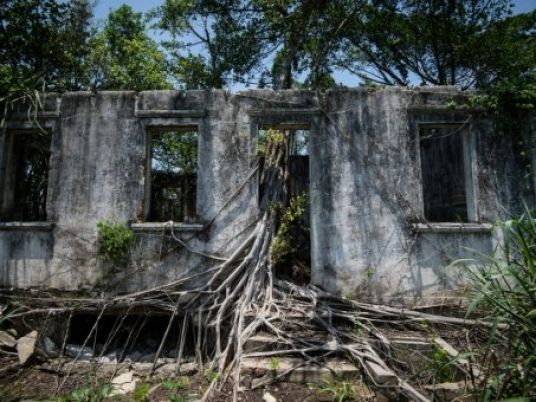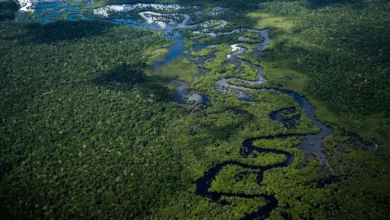
Striding through garbage and abandoned fuel installations on an island in Rio de Janeiro's polluted Guanabara Bay, Brazilian ecologist Sergio Ricardo comes to an unexpected conclusion: "It's a miracle."
To be sure the miracle is some way off.
But if Ricardo and other activists succeed, tiny, deserted Ilha Seca will be the cornerstone of an epic effort to save one of the world's most photogenic bays from destruction.
A one-man force of nature, Ricardo wants to transform the island, a Texaco depot abandoned by the corporation half a century ago, into a kind of marine Garden of Eden.
Fish will be raised in huge seawater tanks to repopulate the bay. Rio universities will conduct research, artisanal fishermen will teach their skills, and Rio residents will come to experience Guanabara as more than today's giant sewage receptacle and oil industry base.
"The government pushes the idea that the bay of Guanabara is dead, that it is finished, that it should be handed over to industrial uses, but the goal we have here is to demonstrate the opposite," Ricardo, 47, said on a recent visit with NGO representatives and other backers.
Visionary
Ankle-deep in plastic bags, old toys, innumerable bottles, and bits of cars and furniture, Ilha Seca's sandy shores reflect what environmentalists describe as the apocalyptic destruction of Guanabara.
Lost in jungle-like undergrowth are a dozen ruined houses and walled enclosures once used for supporting Texaco's storage cylinders. And in every direction across Guanabara's sewage-filled waters rise the modern day installations and anchored ships of Petrobras and other petroleum companies.
Under such pressure, the little island might be imagined a lost cause itself. But Ricardo, who sports a small earring and pony tail, does not seem to recognize lost causes.
Bounding through the foliage and clambering over ghostly ruins at the head of the small party of visitors, he explained his "miracle" in the waiting.
At the core of plans are the structures left behind by Texaco, with the vacated fuel container enclosures providing the pens which would be filled with seawater, then used to raise shrimps, mullet, corvina, robalo — all commercially viable species and native to Guanabara.
"Here will be the biggest of the fish tanks," Ricardo said, pointing into a walled-off area, now choked with half-century old trees. "We can have thousands, tens of thousands of fish in there."
"That house could be the dormitory for fishermen, or a school for their children," he said proudly, indicating a roofless set of walls conquered by tropical growth, including a hefty tree angling through the front door.
Another structural shell, the walls blackened by years of camp fires, will be a rescue station, another the welcome center, another the seafood restaurant — the possibilities in Ricardo's optimistic eyes are endless.
"He's a visionary," said Frederico Tannenbaum, a Rio-based tech entrepreneur, as he listened to the ecologist.
"To be a leader you have to be a little bit crazy. I've got the feeling with him that he already knows it's going to happen."
Legal tangles
Islands in Guanabara Bay are not exactly easy to come by.
Some are inhabited, others are under control of powerful institutions like Petrobras or the navy. Near Ilha Seca there's even a tiny island with a single house reputedly belonging to a veteran mafioso.
But in 2006, a group called the Tubiacanga Association of Free Fishermen, which represents small-scale fishing businesses in the nearby Rio neighborhood of Ilha do Governador, lodged a request with the fisheries ministry for an observatory on Ilha Seca.
After what the fishing association calls "years of struggle," their case was finally given an official hearing — itself a victory in bureaucratic Brazil. In March, the fisheries minister said he saw the idea "positively."
But momentum came to a halt last month when President Dilma Rousseff axed the fisheries ministry in a reshuffle, putting it under control of the agriculture ministry. The case is currently "paralyzed," the fishermen's association says.
Beyond the legal tangles, the project would face enormous costs just to clear the overgrown island, let alone build the fish tanks and other facilities.
But Ricardo says that by promoting local fishing and tourism the observatory would also generate money, directly benefiting up to 400 families.
Mad or hero?
Systemic problems of sanitation infrastructure, political will and social values can make the task of saving Guanabara look hopeless.
For example, official promises to drastically reduce sewage before next summer's Rio Olympics, when sailors and swimmers will use the waters, have been quietly shelved.
Guilherme Karakida, who works for Casa Fluminense, a think tank promoting sustainable development and equality in Rio, said the Ilha Seca plan may look far-fetched, but at the same time the scale of the crisis requires unconventional thinking.
"The role Sergio is playing is perfect — you need someone like him to do that," said Karakida, who was also on the tour. "Guanabara Bay is our unique, most beautiful natural resource in Rio."
Asked if he is unusually brave, even a little crazy, Ricardo smiled.
"Neither," he said. "This observatory will be a new model. It's nothing to do with being mad or brave. Everything I propose is realistic."




